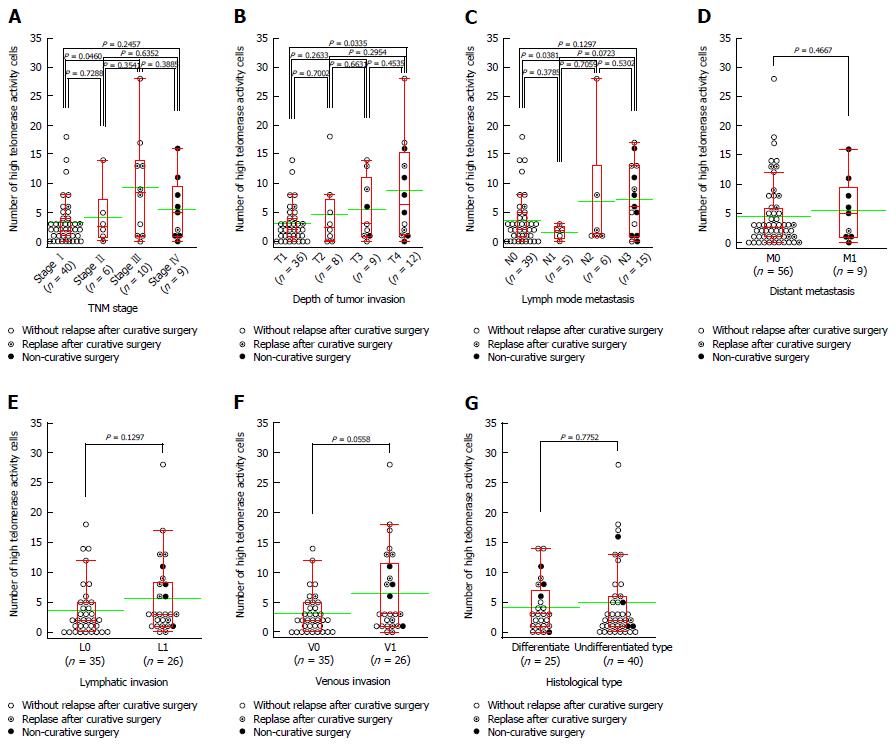Copyright
©The Author(s) 2016.
World J Gastroenterol. Dec 14, 2016; 22(46): 10232-10241
Published online Dec 14, 2016. doi: 10.3748/wjg.v22.i46.10232
Published online Dec 14, 2016. doi: 10.3748/wjg.v22.i46.10232
Figure 2 Relationship between circulating tumour cell number and pathological findings.
Dots indicate the numbers of CTCs in each patient blood sample. The bottom and top of the box represent the lower and upper quartiles, and the band across the box shows the median. The lower and upper bars at the ends of the whiskers show the lowest data point within 1.5 interquartile ranges of the lower quartile, and the highest data point within 1.5 interquartile ranges of the upper quartile, respectively. The green bar shows the average. A: Disease stage (Stages 1-4 indicate disease progression); B: Depth of tumour invasion (T1-T4 indicate increasing depth); C: Lymphatic metastasis (N0-3 indicate number of metastatic lymph nodes); D: Distant metastasis (M0 = negative, M1 = positive); E: Lymphatic invasion (L0 = negative, L1 = positive); F: Venous invasion (V0 = negative, V1-V2 = positive); G: Histological type (differentiated and undifferentiated types). A: Relationship between CTC number and disease stage; B: Relationship between CTC number and T category. The number of CTCs tended to increase with progression of primary tumour. There was a statistically significant difference in the number of CTCs between samples from patients with T1 and those from patients with T4 status (P = 0.0335); C: The relationship between CTC number and N category. There was a statistically significant difference in the number of CTCs between samples from patients with N0 and those from patients with N2 classification (P = 0.0381); D: Relationship between CTC number and M category. There was no significant difference in the number of CTCs between samples from patients with distant metastases and those from patients without distant metastasis (P = 0.4667); E: Relationship between CTC number and lymphatic invasion. The number of CTCs in samples from patients with lymphatic invasion was higher than that in patients without invasion. However, this result did not reach the level of significance (P = 0.1297); F: Relationship between CTC number and venous invasion. The number of CTCs in samples from patients with venous invasion was higher than that in samples from patients without this pathology. However, this result did reach the level of significance (P = 0.0558); G: Relationship between CTC number and histological type. There was no significant difference in the number of CTCs between samples from patients with differentiated tumours and those from patients with undifferentiated tumours (P = 0.7752). CTCs: Circulating tumour cells.
- Citation: Ito H, Sato J, Tsujino Y, Yamaguchi N, Kimura S, Gohda K, Murakami K, Onimaru M, Ohmori T, Ishikawa F, Inoue H. Long-term prognostic impact of circulating tumour cells in gastric cancer patients. World J Gastroenterol 2016; 22(46): 10232-10241
- URL: https://www.wjgnet.com/1007-9327/full/v22/i46/10232.htm
- DOI: https://dx.doi.org/10.3748/wjg.v22.i46.10232









